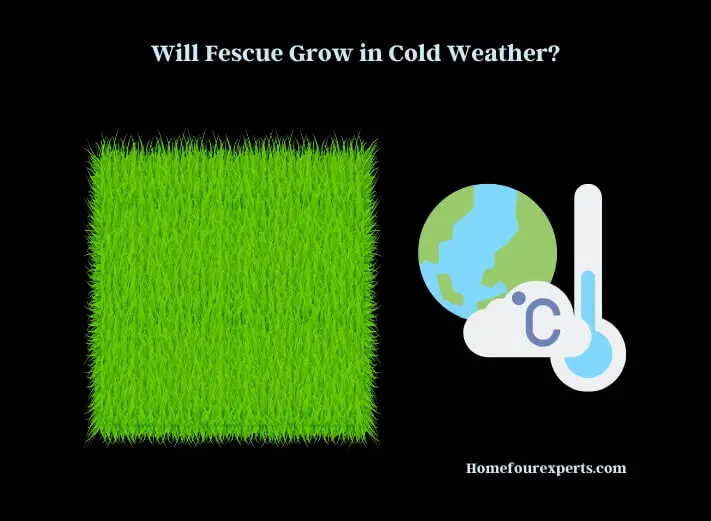
Understanding Fescue Grass
Types of Fescue Grass
Fescue grass, belonging to the genus Festuca, is a popular choice for lawns and landscaping projects due to its adaptability and resilience. There are various types of fescue grass, including:
- Tall fescue
- Fine fescue (which includes creeping red fescue, chewings fescue, hard fescue, and sheep fescue)
Each variety has its unique characteristics, making them suitable for different environments and applications.
Characteristics of Fescue Grass
Fescue grass is known for its:
- Shade tolerance
- Drought resistance
- Low maintenance requirements
- Deep root system
- Pest and disease resistance
These characteristics make fescue grass an excellent choice for many homeowners and landscapers.
Cold Weather and Fescue Grass Growth
Optimal Growing Conditions for Fescue Grass
Fescue grass generally thrives in cooler climates with temperatures ranging from 50 to 75°F (10 to 24°C). However, it can still grow in colder conditions, although its growth rate may slow down.
Challenges Faced by Fescue Grass in Cold Weather
In colder weather, fescue grass faces some challenges, such as:
- Reduced photosynthesis due to shorter daylight hours
- Limited nutrient uptake due to frozen or compacted soil
- Potential damage from ice and snow accumulation
Cold Tolerance of Different Fescue Varieties
Different fescue varieties have varying levels of cold tolerance. For example, tall fescue is relatively cold-hardy and can survive in colder climates, while fine fescue varieties like creeping red and chewings fescue are more cold-tolerant than tall fescue.
Growing Fescue in Cold Weather Regions
Selecting the Right Fescue Variety
When choosing a fescue variety for cold weather regions, consider the following factors:
- Cold tolerance
- Resistance to local pests and diseases
- Overall appearance and desired lawn characteristics
Preparing the Soil
Proper soil preparation is essential for successful fescue grass growth in cold weather regions. Be sure to:
- Conduct a soil test to determine the pH and nutrient levels
- Amend the soil as needed to create optimal growing conditions
Planting Fescue in Cold Weather
Planting fescue grass in cold weather regions is best done during the fall, as this allows the grass to establish itself before the onset of harsh winter conditions. Follow these steps for successful planting:
- Clear the planting area of any debris and weeds.
- Loosen the soil to a depth of 4 to 6 inches (10 to 15 cm) using a rototiller or garden fork.
- Level the soil and remove any rocks or large clumps.
- Apply a starter fertilizer to promote strong root growth.
- Sow the fescue grass seed evenly, using a broadcast spreader or by hand.
- Rake the soil lightly to cover the seeds with a thin layer of soil.
- Water the area thoroughly to encourage germination.
Caring for Fescue Grass in Cold Weather
Fertilization
Fertilizing fescue grass in cold weather regions is essential for maintaining a healthy lawn. Apply a slow-release nitrogen fertilizer in the fall to help the grass store nutrients for the winter months.
Watering
Water your fescue lawn as needed during the fall and early winter, ensuring the soil remains consistently moist but not waterlogged. Reduce watering frequency as temperatures drop to avoid creating ice patches on the lawn.
Mowing
Mow your fescue grass regularly during the fall, maintaining a height of 2.5 to 3 inches (6 to 7.5 cm). Gradually raise the mowing height as winter approaches to provide insulation against the cold.
Conclusion
Fescue grass can grow in cold weather regions, provided the right variety is selected, and proper care is taken during planting and maintenance. By understanding the challenges faced by fescue grass in cold weather and addressing them, you can enjoy a beautiful, healthy lawn throughout the year.
FAQs
- Is fescue grass suitable for all cold weather regions?
Not all fescue varieties are suitable for every cold weather region. Choose a variety that is cold-tolerant and well-adapted to your specific climate.
- Can I plant fescue grass in the winter?
It is best to plant fescue grass in the fall, as this allows it to establish itself before the harsh winter conditions set in.
- How do I protect my fescue lawn from winter damage?
Maintain a slightly higher mowing height during the winter, avoid walking on the lawn when it’s covered in frost or snow, and remove any heavy snow accumulations to minimize damage.
- When should I fertilize my fescue lawn in cold weather regions?
Apply a slow-release nitrogen fertilizer in the fall to help your fescue lawn store nutrients for the winter months.
- How much water does fescue grass need in cold weather regions?
Water your fescue lawn as needed during the fall and early winter, ensuring the soil remains consistently moist but not waterlogged. Reduce watering frequency as temperatures drop.
Read more:
About This Writer

Hi, I am Eric Devin and I am a professional interior architect. Since childhood, I've always enjoyed DIY projects! And, I have loved to solve simple household problems using essential tools and equipment. I have also acquired a lot of information about basic household tools settings by working with contractors.